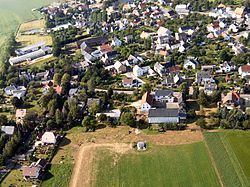Postal codes 08451 Area 61.04 km² Local time Friday 6:54 PM Dialling code 03762 | Time zone CET/CEST (UTC+1/+2) Dialling codes 03762 Population 21,392 (31 Dec 2008) Postal code 08451 Team ETC Crimmitschau | |
 | ||
Weather 9°C, Wind S at 10 km/h, 50% Humidity | ||
Del2 highlights 50 spieltag heilbronner falken vs eispiraten crimmitschau
Crimmitschau ( [ˈkʁɪmɪtʃaʊ]) is a town in the district of Zwickau in the Free State of Saxony.
Contents
- Del2 highlights 50 spieltag heilbronner falken vs eispiraten crimmitschau
- Map of Crimmitschau Germany
- Del2 14 spieltag ehc bayreuth etc crimmitschau
- Geography
- Neighboring municipalities
- Municipality subdivisions
- History
- Religion
- International relations
- Museums
- Buildings
- Music
- Parks
- Sports
- Business and Infrastructure
- Education
- Personalities
- Honorary citizen
- References
Map of Crimmitschau, Germany
Del2 14 spieltag ehc bayreuth etc crimmitschau
Geography
Crimmitschau lies on the River Pleiße in the northern foothills of the Erzgebirge.
Neighboring municipalities
Adjacent communities include: Zwickau, Dennheritz, Neukirchen, Meerane, and Langenbernsdorf in Landkreis of Zwickau; Heyersdorf, Jonaswalde, Ponitz and Thonhausen in Thuringian Landkreis of Altenburger Land; as well as Braunichswalde, Rückersdorf, and Seelingstädt in Thuringia in Landkreis of Greiz.
Municipality subdivisions
Crimmitschau's subdivisions are Rudelswalde, Lauenhain, Langenreinsdorf, Mannichswalde, Frankenhausen, Wahlen, Gösau, Gosel, Gablenz, Blankenhain, Großpillingsdorf, and Harthau.
History
In the course of German eastward expansion, the city of Crimmitschau and a castle of the same name (now called the Schweinsburg) were established from around 1170 to 1200 as an organized German colony. The settlement's existence is first documented in 1212. In 1414 Crimmitschau received town privileges from Markgraf Wilhelm II.
On 15 March 1844, Crimmitschau was connected to the German rail network (on the Leipzig–Hof railway, which was later extended to Bavaria). Its current station was opened in 1873
Around the turn of the century, Crimmitschau was the site of a large concentrated textile industry, and was called "The City of 100 chimneys" (Stadt der 100 Schornsteine).
From August 22, 1903 to January 18, 1904, it was the site of one of the largest and longest strikes in the German Empire, which affected the entire nation.
In 1944, some Crimmitschau property was bombed by Allied Forces.
At the end of the 1980s, a great part of the old and inner cities were torn down and replaced with prefabricated concrete buildings. Similar plans existed for the southern suburb, but were not put in place after the regime change in 1990.
Religion
Even though almost 50 percent of the people in the Crimmitschau area are Atheists, there are some Protestant parishs and even a catholic parish, belonging to the Diocese of Dresden-Meissen. The most important churches are: St. Laurentius-Kirche, Johanniskirche, and the Lutherkirche.
International relations
Crimmitschau is twinned with:
Museums
Buildings
Landmarks include the town hall, the late gothic parish church of Saint Larentus (1513), with its star and cross ribbed arches, a former Cistercian Convent (founded around 1290) in the district of Frankenhausen and the open-air museum of Blankenhain Castle located at the castle of the same name.
Music
Parks
Sports
Crimmitschau has a well-known ice hockey club, the ETC Crimmitschau, which plays in the second highest German league. The city also has a soccer team, FC Crimmitschau and an American Football Team, the Tornados Crimmitschau.
Business and Infrastructure
Crimmitschau lies directly at the Autobahn A4 and can be reached through the exits Schmölln and Meerane. The Deutsche Bahn AG provides connections from Crimmitschau station to Zwickau, Leipzig, Hof.
Education
There are 3 elementary schools (Grundschule), two secondary schools (Mittelschule), a high school (Gymnasium), and a special education school (Förderschule) in Crimmitschau:
